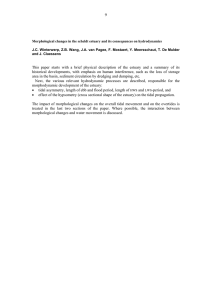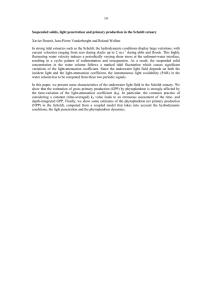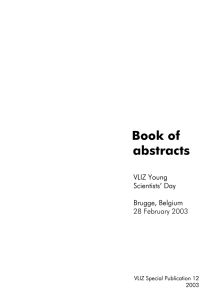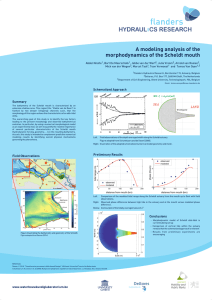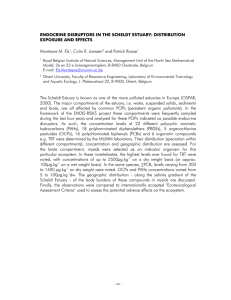SIMULATION OF LONG-TERM MORPHODYNAMICS OF THE WESTERN SCHELDT IAHR World Congress
advertisement
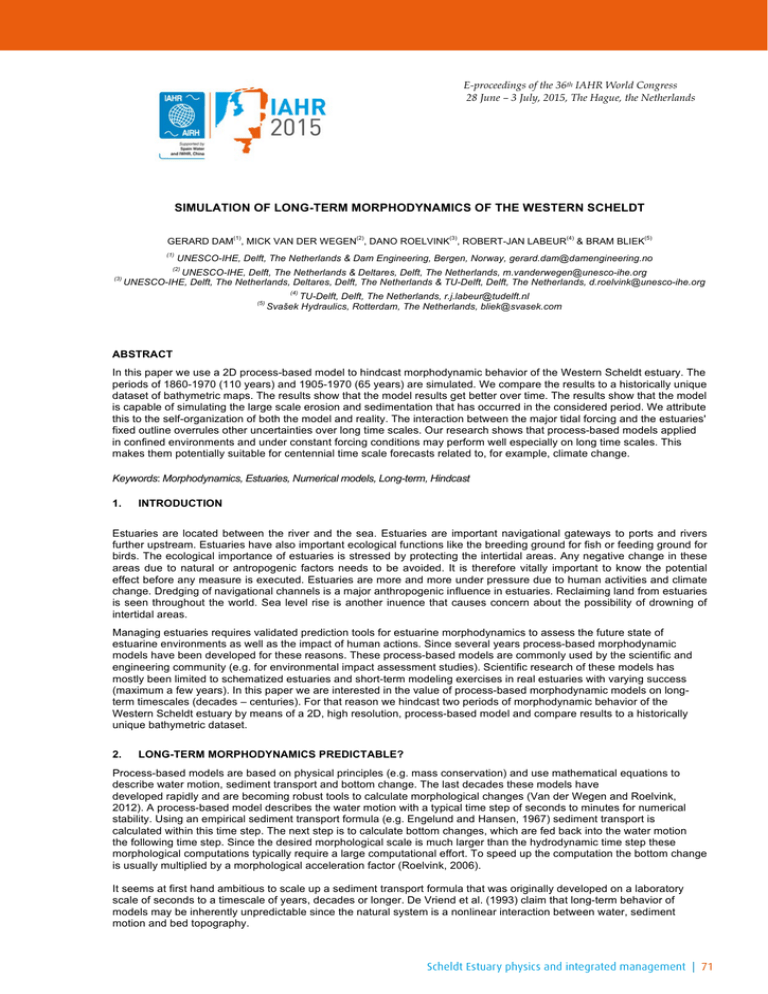
E-proceedings of the 36th IAHR World Congress 28 June – 3 July, 2015, The Hague, the Netherlands SIMULATION OF LONG-TERM MORPHODYNAMICS OF THE WESTERN SCHELDT (1) (2) (3) GERARD DAM , MICK VAN DER WEGEN , DANO ROELVINK , ROBERT-JAN LABEUR (1) (4) & BRAM BLIEK (5) UNESCO-IHE, Delft, The Netherlands & Dam Engineering, Bergen, Norway, gerard.dam@damengineering.no (2) (3) UNESCO-IHE, Delft, The Netherlands & Deltares, Delft, The Netherlands, m.vanderwegen@unesco-ihe.org UNESCO-IHE, Delft, The Netherlands, Deltares, Delft, The Netherlands & TU-Delft, Delft, The Netherlands, d.roelvink@unesco-ihe.org (4) (5) TU-Delft, Delft, The Netherlands, r.j.labeur@tudelft.nl Svašek Hydraulics, Rotterdam, The Netherlands, bliek@svasek.com ABSTRACT In this paper we use a 2D process-based model to hindcast morphodynamic behavior of the Western Scheldt estuary. The periods of 1860-1970 (110 years) and 1905-1970 (65 years) are simulated. We compare the results to a historically unique dataset of bathymetric maps. The results show that the model results get better over time. The results show that the model is capable of simulating the large scale erosion and sedimentation that has occurred in the considered period. We attribute this to the self-organization of both the model and reality. The interaction between the major tidal forcing and the estuaries' fixed outline overrules other uncertainties over long time scales. Our research shows that process-based models applied in confined environments and under constant forcing conditions may perform well especially on long time scales. This makes them potentially suitable for centennial time scale forecasts related to, for example, climate change. Keywords: Morphodynamics, Estuaries, Numerical models, Long-term, Hindcast 1. INTRODUCTION Estuaries are located between the river and the sea. Estuaries are important navigational gateways to ports and rivers further upstream. Estuaries have also important ecological functions like the breeding ground for fish or feeding ground for birds. The ecological importance of estuaries is stressed by protecting the intertidal areas. Any negative change in these areas due to natural or antropogenic factors needs to be avoided. It is therefore vitally important to know the potential effect before any measure is executed. Estuaries are more and more under pressure due to human activities and climate change. Dredging of navigational channels is a major anthropogenic influence in estuaries. Reclaiming land from estuaries is seen throughout the world. Sea level rise is another inuence that causes concern about the possibility of drowning of intertidal areas. Managing estuaries requires validated prediction tools for estuarine morphodynamics to assess the future state of estuarine environments as well as the impact of human actions. Since several years process-based morphodynamic models have been developed for these reasons. These process-based models are commonly used by the scientific and engineering community (e.g. for environmental impact assessment studies). Scientific research of these models has mostly been limited to schematized estuaries and short-term modeling exercises in real estuaries with varying success (maximum a few years). In this paper we are interested in the value of process-based morphodynamic models on longterm timescales (decades – centuries). For that reason we hindcast two periods of morphodynamic behavior of the Western Scheldt estuary by means of a 2D, high resolution, process-based model and compare results to a historically unique bathymetric dataset. 2. LONG-TERM MORPHODYNAMICS PREDICTABLE? Process-based models are based on physical principles (e.g. mass conservation) and use mathematical equations to describe water motion, sediment transport and bottom change. The last decades these models have developed rapidly and are becoming robust tools to calculate morphological changes (Van der Wegen and Roelvink, 2012). A process-based model describes the water motion with a typical time step of seconds to minutes for numerical stability. Using an empirical sediment transport formula (e.g. Engelund and Hansen, 1967) sediment transport is calculated within this time step. The next step is to calculate bottom changes, which are fed back into the water motion the following time step. Since the desired morphological scale is much larger than the hydrodynamic time step these morphological computations typically require a large computational effort. To speed up the computation the bottom change is usually multiplied by a morphological acceleration factor (Roelvink, 2006). It seems at first hand ambitious to scale up a sediment transport formula that was originally developed on a laboratory scale of seconds to a timescale of years, decades or longer. De Vriend et al. (1993) claim that long-term behavior of models may be inherently unpredictable since the natural system is a nonlinear interaction between water, sediment motion and bed topography. 1 Scheldt Estuary physics and integrated management | 71 E-proceedings of the 36th IAHR World Congress, 28 June – 3 July, 2015, The Hague, the Netherlands Stive and Wang (2003) claim that the ability to hindcast or predict the evolution of tidal inlets at decadal to century time scales remains questionable. Furthermore hindcasting decadal-timescale bathymetric change in estuaries is prone to error due to limited data for initial conditions, boundary forcing, and calibration (Ganju et al., 2009). Small deviations in for example parameter settings might cause large errors in the long term since the errors begin to accumulate (Roelvink and Reniers, 2011). Haff (1996) points to different sources of uncertainty or error that arise in attempting to model at longer time scales : (i) model imperfection, (ii) omission of important processes, (iii) lack of knowledge of initial conditions, (iv) sensitivity to initial conditions, (v) unresolved heterogeneity, (vi) occurrence of external forcing, and (vii) inapplicability of the factor of safety concept. Generally hindcast periods greater than a few years are considered unreliable. These authors suggests that long-term modeling is difficult, if not impossible. On the other hand several studies have shown that realistic patterns emerge if the model starts from a flat bed. Hibma et al. (2003) show that self-organization of pattern formations in a highly schematized estuary can be simulated with a process-based model and gives reasonable resemblance with patterns found in reality. The reason why the model was capable of simulating these patterns is a positive feedback between currents and bathymetry. Van der Wegen and Roelvink 2008, Van der Wegen et al. (2008, 2010) extended this research for millennia timescales and concluded that a relative simple process-based model can describe at least in some degree the morphodynamics of estuaries. The positive feedback mechanism between currents and bathymetry is responsible for more or less stable results after long timescales with little sensitivity to the model settings or sediment transport formula. Van der Wegen and Roelvink (2012) also showed that a process-based model is capable of reproducing the channel-shoal pattern using the Western Scheldt geometry with considerable skill starting from a flat bathymetry. The reason is that the interaction between tidal forcing, sediment availability and the basin geometry plays a major role in the morphological development of a tidal dominated basin. Other researchers also concluded that starting from a flat bed process-based models can produce realistic patterns in tidal inlets (Cayocca, 2001; Marciano et al., 2005; Dastgheib et al., 2008; Dissanayake et al., 2009). To conclude: most research on long-term timescales using a process-based model has been carried out for schematized estuaries. In these cases the models produce patterns that are observed in reality. Real hindcasts over decadal to century timescales are still scarce. It is therefore important to test these models on these time scales and to know the value of process-based models for scientific and engineering reasons. 3. CASE STUDY: WESTERN SCHELDT ESTUARY We take the Western Scheldt as a case study to test the ability of process-based morphological models on long time scales. The Scheldt estuary is one of the major estuaries of North-West Europe. The estuary is approximately 160 km long and is located both in Dutch and Belgian territory. The down-estuarine part (last 60 km) is called the Western Scheldt (Figure 1) and is characterized by a width of almost 5 km near the mouth and 1 km near the Dutch-Belgian border. The mean tidal range increases from 3.8 m at the mouth to over 5.0 m near Antwerp almost 80 km from the mouth of the estuary (see Figure 1). The estuary mainly consists of medium to fine sand. Mud is usually only found in intertidal areas. The river discharge is of minor importance since the fresh water discharge, on average 120 m³/s, is only 0.6% of the tidal prism at the mouth (Van der Spek, 1997). The estuary is well-mixed. The Western Scheldt incorporates large areas of tidal flats and salt marshes. Nature is therefore an important function and stringent EU and national legislation is maintained to safeguard its natural values. Equally important are the functions of the estuary in the safety against flooding and the access to the Port of Antwerp. Figure 1. Layout of the Western Scheldt around 1970 with names of important channels and dredging areas and tidal stations The Western Scheldt has a multiple channel system. Ebb and flood channels show an evasive character separated by inter tidal shoals (Van Veen, 1950). The ebb channel has a meandering character, while the flood channel is straighter. The ebb flow reaches it maximum velocity near mean sea level (MSL), while the flood flow reaches its peak one hour 2 72 | Scheldt Estuary physics and integrated management E-proceedings of the 36th IAHR World Congress 28 June – 3 July, 2015, The Hague, the Netherlands before high water (Van den Berg et al., 1996). As a consequence the ebb flow is more concentrated in the channels, resulting in deeper ebb channels. The ebb channel is therefore generally designated as the navigational channel in the Western Scheldt. In this paper two periods are considered: 1860-1970 (110 years) and 1905-1970 (65 years). Figure 2 shows the observed bathymetries from 1860 to 1970. In this period large morphodynamic changes have occurred as can be seen from Figure 2. In the 1970’s and 1990’s a deepening and widening of the navigational channel has been carried out to allow vessels with greater draught to enter the port of Antwerp. Recently, in 2010, a third deepening has been completed. Dredging 3 volumes after 1970 range in the order from 5-14 million m per year in the estuary. Before 1970 the dredging operations concentrated to a few sills in the eastern part of the estuary. The hindcasts are therefore limited till 1970, before the major dredging operations started, in order to answer the question if we are able to hindcast the (relative) natural morphodynamic behavior of the system over this 110 year period. In the past centuries large land reclamations have narrowed the estuary. The land reclamations in both simulations are taken into account. The tide and morphology are inter-related. In Wang et al. (2002) this is described by saying that (1) changes in morphology lead to (2) changes in tidal levels, which lead to (3) differences in ebb and flood velocities that (4) causes residual transport of sediment, with a feedback into (1). In principle this feedback loop is described by a process-based model, although its practical value in long-term morphodynamic calculations has not been proven yet. Figure 2. Five measured bed levels with respect to Mean Sea Level (MSL) of the Western Scheldt. a, 1860. b, 1905. c, 1931. d, 1955. e, 1970. Black line indicates the present day plan form. Coordinate system in Dutch National Grid. 3 Scheldt Estuary physics and integrated management | 73 E-proceedings of the 36th IAHR World Congress, 28 June – 3 July, 2015, The Hague, the Netherlands 4. THE MORPHODYNAMIC MODEL: FINEL2D The process-based model that is applied in this study is called FINEL2d. The model is a 2DH process-based model based on the finite element method. The depth-integrated shallow water equations are the governing equations of the flow module. For details about FINEL2d reference is made to Dam et al. (2007). Other examples of the FINEL2d model are Dam et al. (2005, 2009, 2013b) and Dam and Bliek (2013). FINEL2d uses an unstructured triangular grid. The advantage of such a mesh in comparison to for example a finite difference grid is the flexible mesh generation. In FINEL2d no nesting techniques are required in regions of specific interest, where a higher degree of resolution is needed, while arbitrary coastlines and complex geometries can be resolved very well. The seaward boundaries of the computational mesh of the Western Scheldt are chosen approximately 40 km away from the coastline and coincide with the boundaries of existing models. The latter can be used to obtain the corresponding boundary conditions. The major part of the Scheldt-estuary in Belgium is also included in the schematization. In Figure 3 the overall mesh is shown. In the area of interest, the Western Scheldt, the average grid size is approximately 1.1 ha 2 (~100 by 100m). Near the seaward boundaries the grid size is approximately 2.5 km (~1600 by 1600 m). The total number of elements (triangles) of the mesh is 59,937. Figure 3. FINEL2d model grid of the Scheldt estuary (1860 outline). On the seaward side of the grid astronomical tidal boundary conditions are given, while on the river side constant (yearly averaged values) river discharges are taken. Only the influence of the tidal action on the morphology is taken into account. Wave action is ignored for simplicity reasons, although intertidal areas can be influenced by wave action. To speed up the morphological calculation a morphological acceleration factor (MF) is used every timestep to multiply the bed level changes (Roelvink, 2006). In this case a MF of 24.75 is applied in accordance with Dam et al. (2007). One neap-spring cycle for the water motion represents a morphodynamic year with this setting. A parameterization of the spiral flow was implemented according to Kalkwijk and Booij (1986). The calibration of the model on the water motion and the sandy morphology for the entire Scheldt estuary is carried out in Dam et al. (2007) with an update in 2013 (Consortium Deltares-IMDC-Svasek-Arcadis, 2013). The model was first calibrated on water levels at the main tidal stations (not presented here). This resulted in a global k-nikuradse roughness of 0.01 m. The model was validated for tidal currents in both the channels and inter tidal areas. The model showed good agreement between current observations and model results (Consortium Deltares-IMDC-Svašek-Arcadis, 2013). Although a dredging module is available in the model (e.g. Dam et al., 2013b), this option is specifically not used in this paper, since we are interested in the (relative) natural behavior of the system before 1970. When dredging is included in the model, the results might be artificially influenced. The optimal settings for the morphodynamic model found in the calibration are given in Table 1. These settings are used in the model computations discussed in this paper. 4 74 | Scheldt Estuary physics and integrated management E-proceedings of the 36th IAHR World Congress 28 June – 3 July, 2015, The Hague, the Netherlands The land reclamations are taken into account in the computation. The borders of the land reclamations coincide with the computational mesh. At the year of closure a weir is implemented in the model, so that this section is closed off from the tidal influence and morphodynamic activity in the closed-off section stops. A hindcast of the years 1965 to 2002 is described in Dam et al. (2007), which was updated recently (Consortium Deltares-IMDC-Svasek-Arcadis, 2013 and Dam et al, 2013b). Table 1. Model settings. 5. PARAMETER VALUE Sediment transport formula Grain size (d50) Fall velocity of sand Morphological acceleration factor Non-erodable layers Hydraulic roughness Dredging module Engelund- Hansen Variable (150 to 300 µm) Variable 24.75 From government data 1 cm off RESULTS EROSION/SEDIMENTATION PATTERN Using the model settings as described in the previous section a simulation is carried out for the period 1860-1970. Previous results of the 1860-1970 computation are described in Dam et al. (2013a). Several observed bathymetries are available to compare the model results. Here we limit the comparison to the year 1970. Figure 4 shows the erosion and sedimentation pattern for the 1860-1970 period for both model and measurement (110 years). Figure 5 shows the modeled and measured erosion/sedimentation pattern for the 1905-1970 period (65 years). The results show that the model is capable of simulating most of the observed morphological changes in the estuary. Especially large scale erosion or sedimentation is predicted well by the model. This is valid for both the 1860 as the 1905 computation. On smaller scales still differences can be seen. This means that the astronomical tidal forcing is the dominant forcing for the large scale morphology. Another conclusion is that forcings like storms or large river discharges do not play a large role in the largescale and long-term development of the estuary. In the next section a more objective method is used to compare the model results with the measurements. Figure 4. Erosion and sedimentation patterns of the 1860-1970 period. a, Modeled. b, Measured. Black dashed line indicates the 1860 plan form. Black solid line indicates the -5m contour line of the 1860 bed level. Black numbers indicate Brier-Skill Scores for sections indicated by the green dashed lines. 5 Scheldt Estuary physics and integrated management | 75 E-proceedings of the 36th IAHR World Congress, 28 June – 3 July, 2015, The Hague, the Netherlands Figure 5. Erosion and sedimentation patterns of the 1905-1970 period. a, Modeled. b, Measured. Black dashed line indicates the 1860 plan form. Black solid line indicates the -5m contour line of the 1860 bed level. Black numbers indicate Brier-Skill Scores for sections indicated by the green dashed lines. 6. RESULTS USING THE BRIER-SKILL SCORE To objectively compare measured and modeled bed changes, we use the Brier-Skill Score (BSS), see equation (1) (Sutherland et al., 2004). BSS = 1 − (Y − X )2 (B − X )2 [1] where: X= measured bed level [m]; Y= modeled bed level [m]; B= initial bed level [m]. And the <> denote an arithmetic mean, i.e. averaged over the model domain in this case. The following rating of the BSS for morphological models is used (Sutherland et al., 2004): Table 2. Rating of Brier-Skill Scores. RATING VALUE OF BSS Bad Poor Reasonable/Fair Good Excellent <0 0 - 0.1 0.1 – 0.3 0.3 – 0.5 0.5 – 1.0 6 76 | Scheldt Estuary physics and integrated management E-proceedings of the 36th IAHR World Congress 28 June – 3 July, 2015, The Hague, the Netherlands As a reference, weather forecasting considers a BSS over 0.2 to be a useful prediction (Murphy and Epstein, 1989). Figure 6 shows the BSS values for both computations with all available measured bathymetries. The 1860 run shows that the BSS is initially negative (red line) but increases to become 0.52 (excellent) after 110 years for the entire Western Scheldt. The 1905 run shows similar behavior: the BSS is also increasing over time and becomes 0.46 after 65 years of simulating for the complete Western Scheldt. So the conclusion that the model results get better over time is independent of the initial bed level. In Figure 4 and 5 BSS values are given for different sections of the estuary. The most western section scores the highest BSS value of around 0.7 in both the 1860 as the 1905 computation. Generally BSS values decrease towards the east. The most eastern section scores negative BSS values for both runs. An explanation for this is that in this part of the estuary dredging has taken place in the considered period and this was not included in the simulation. Figure 6. Brier-Skill Score for simulations with startyear 1860 and 1905. Markers indicate comparisons between model and data, solid lines interpolate between subsequent comparisons. 7. CONCLUSIONS Contrary to common perception the results found in this paper show that long-term morphodynamics in estuaries is predictable. The results in the long-term are better than the short-term. An explanation for the initial low BSS is that the model needs to adjust the (observed) bathymetry according to its unknown parameter settings, boundary forcing and process descriptions. The number of possible morphological outcomes seems endlessly and unpredictable, but in reality the outcomes are limited due to a few reasons: first of all self-organization is leading the morphological changes, which is reproduced by the model. As a consequence large channels are aligned more efficiently. Secondly the interaction of the tide with the estuarine geometry (i.e. fixed banks and non-erodable layers) is an important process (Van der Wegen and Roelvink, 2012). Thirdly the well predictable tide is the governing forcing. Stochastic forcing like storms and river discharge are limited. This makes that the number of possible morphological outcomes is limited even further. Process-based models applied in the confined environment of an estuary and subject to constant tidal and river forcing conditions perform well especially on long (> decades) time scales, which makes the approach potentially suitable for centennial time scale forecasts related to for example sea level rise or other gradual changes in forcing with a similar time scale. ACKNOWLEDGMENTS This work was made possible by contributions of Svašek Hydraulics and the Long term vision of the Scheldt project (LTV V&T). The project consists of Deltares, IMDC, Arcadis and Svašek Hydraulics and was funded by the Dutch ministry of public works (Rijkswaterstaat) and Flemish department of mobility and public works. 7 Scheldt Estuary physics and integrated management | 77 E-proceedings of the 36th IAHR World Congress, 28 June – 3 July, 2015, The Hague, the Netherlands REFERENCES Cayocca, F. (2001). Long-term morphological modeling of a tidal inlet: the Arcachon Basin, France. Coastal Engineering, 42 (2): 115-142. Consortium Deltares-IMDC-Svašek-Arcadis (2013). Actualisatie FINEL2d model van de Westerschelde. LTV V&T report A-26 (in Dutch). Dam, G. and Bliek, A.J. (2013). Using a sand-mud model to hindcast the morphology near Waarde, the Netherlands. Maritime Engineering, Volume 164, Issue MA1. Dam, G., Bliek, A.J. and Bruens, A.W. (2005). Band Width analysis morphological predictions Haringvliet Estuary. Proceedings of 4th IAHR symposium of the River, Coastal and Estuarine Morphodynamics Conference. Urbana, USA: 171–179. Dam, G., Bliek, A.J., Labeur, R.J., Ides, S. and Plancke, Y. (2007). Long term process-based morphological model of the Western Scheldt estuary. Proceedings of 5th IAHR symposium of the River, Coastal and Estuarine Morphodynamics Conference. Enschede, The Netherlans: 1077–1084. Dam, G., Bliek, A.J. and Nederbragt, G. J. (2009). High resolution long term morphological model of the northern part of the Holland Coast and Texel Inlet. Proceedings of 5th IAHR symposium of the River, Coastal and Estuarine Morphodynamics Conference. Santa Fe, Argentina: 933-939. Dam, G., Van der Wegen, M. and Roelvink, J.A. (2013a), Long-term performance of process-based models in estuaries. Proceedings of the Coastal Dynamics conference, Archachon, France. Dam, G., Poortman, S.E., Bliek, A.J., and Y. Plancke (2013b), Long-term modeling of dredging strategies on morpho- and th hydrodynamic developments in the Western Scheldt. Proceedings of the 20 WODCON conference. Brussels, Belgium. Dastgheib, A., Roelvink, J. A., and Wang, Z. B. (2008). Long-term process-based morphological modeling of the Marsdiep Tidal Basin. Marine Geology, 256 (1-4): 90-100. De Vriend, H. J., Capobianco, M., Chesher, T., de Swart, H. E., Latteux, B. and Stive, M. J. F. (1993). Approaches to longterm modelling of coastal morphology: A review. Coastal Engineering, 21 (1-3): 225-269. Dissanayake, D. M. P. K., Roelvink, J. A. and Van der Wegen, M. (2009). Modelled channel patterns in a schematized tidal inlet. Coastal Engineering, 56 (11-12): 1069-1083. Engelund, F., Hansen, E., (1967). A Monograph on Sediment Transport in Alluvial Streams. Teknisk Forlag, 1-63. Copenhagen, Denmark. Ganju, N. K., Schoellhamer, D. H. and Jaffe, B. E. (2009). Hindcasting of decadal-timescale estuarine bathymetric change with a tidal-timescale model. Journal of Geophysical Research, 114 (F4). Haff, P. (1996). Limitations on predictive modeling in geomorphology. In: Rhoads, B., Thorn,C. (Eds.), The scientific nature of geomorphology. Wiley: New York, 337-358. Hibma, A., De Vriend, H.J. and Stive, M.J.F. (2003). Numerical modelling of shoal pattern formation in well-mixed elongated estuaries. Estuarine, Coastal and Shelf Science, 57(5-6): 981-999. Hibma, A., Schuttelaars, H. M., and De Vriend, H.J. (2004). Initial formation and long-term evolution of channel shoal patterns. Continental Shelf Research, 24 (15): 1637-1650. Kalkwijk, J.P.T., and Booij, R. (1986). Adaptation of secondary flow in nearly-horizontal flow. Journal of Hydraulic Research, 24 (1): 19-37. Marciano, R., Wang, Z. B., Hibma, A., de Vriend, H.J., and Defina, A. (2005). Modeling of channel patterns in short tidal basins. Journal of Geophysiscal Research, 110 (F1). Murphy, A. H. and Epstein, E. S. (1989) Skill scores and correlation coefficients in model verification. Mon. Weather Rev. 117, 572–581. Roelvink, J.A., (2006). Coastal morphodynamic evolution techniques. Coastal Engineering, 53 (2-3): 277-287. Roelvink, J.A. and Reniers, A.J.H.M. (2011). A guide to modelling coastal morphology. Advances in Coastal and Ocean Engineering. World Scientific, Singapore. Stive, M.J.F., and Wang, Z.B. (2003). Morphodynamic Modeling of Tidal Basins and Coastal Inlets. Elsevier oceanography series 67: 367-392. Sutherland, J., Peet, A.H., and Soulsby, R.L. (2004). Evaluating the performance of morphological models. Coastal Engineering, 51 (8-9): 917-939. Van den Berg, J.H., Jeuken, M.C.J.L. and Van der Spek, A.J.F. (1996). Hydraulic processes affecting the morphology and evolution of the Westerschelde estuary. Estuarine shores: Evolution, Environments and Human Alterations. Van der Spek, A.J.F. (1997). Tidal asymmetry and long-term evolution of Holocene tidal basins in the The Netherlands: simulation of paleo-tides in the Schelde estuary. Marine Geology, 141 (1-4): 71-90. Van der Wegen, M., and Roelvink, J.A. (2008). Long-term morphodynamic evolution of a tidal embayment using a twodimensional, process-based model. Journal of Geophysical Research, 114 (C4). Van der Wegen, M., Wang, Z.B., Savenije, H.H.G., and Roelvink, J.A. (2008). Long-term morphodynamic evolution and energy dissipation in a coastal plain, tidal embayment. Journal of Geophysical Research, 113 (F3). Van der Wegen, M., Dastgheib, A., and Roelvink, J.A. (2010). Morphodynamic modeling of tidal channel evolution in comparison to empirical PA relationship. Coastal Engineering, 57 (9): 827-837. Van der Wegen, M., Jaffe, B.E., and Roelvink, J.A. (2011). Process-based, morphodynamic hindcast of decadal deposition patterns in San Pablo Bay, California, Journal of Geophysical Research, 116 (F02008): 1856–1887. Van der Wegen, M. and Roelvink, J.A. (2012). Reproduction of estuarine bathymetry by means of a process-based model: Western Scheldt case study, the Netherlands. Geomorphology. Van der Wegen, M., and Jaffe, B.E. (2013). Towards a probabilistic assessment of process-based, morphodynamic models, Coastal Engineering. Van Veen, J. (1950). Ebb and flood channel systems in Dutch tidal waters. Tijdschrift Koninklijk Nederlands Aardwetenschappelijk Genootschap (67), 406-413 (in Dutch). 8 78 | Scheldt Estuary physics and integrated management E-proceedings of the 36th IAHR World Congress 28 June – 3 July, 2015, The Hague, the Netherlands Wang, Z.B., Jeuken, M.C.J.L. Gerritsen, H., De Vriend H.J. and Kornman, B.A. (2002). Morphology and asymmetry of the vertical tide in the Westerschelde estuary. Continental Shelf Research, 22: 2599-2609. 9 Scheldt Estuary physics and integrated management | 79
